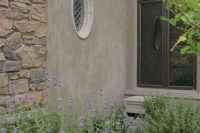Stucco Stop
How to Avoid Issues When Applying Stucco
Good Stucco Gone Bad








Stucco is, and will always be, an affordable, impact resistant, durable exterior cladding. And, we all know how long stucco has been around … “Pharaoh, long time.” This hearty cladding we call stucco has been successfully performing as a decorative and durable protection layer for our “things” we keep inside. Bottom line, stucco rocks—pun intended.
So when stucco goes bad, or is perceived to be bad, what goes wrong? To understand potential issues, or the perception of issues, requires the understanding of the assembly, how it is installed and how performance is tied to standards and codes. A prescriptive approach is outlined in ASTM C897 (sand), C926 (stucco application) and C1063 (lath). These standards are the baselines for stucco and outline specifics to mixing, temperature, products etc. This begs the question, if the exact verbiage is not followed, does that mean the stucco is going to fail? Let’s look at the possibilities.
There are stages of proper completion that must be in place before stucco can go on. The framing must be code compliant, in a true plane and have a deflection minimum of L/360. The wood sheathing must be gapped. The fenestrations must be flashed. All construction dead load, i.e. roofing, drywall hung on exterior walls, and pour in place flooring (wood framed lightweight products) need to be in place. Finally, windows and doors should be installed.
Lath
Think of this as a two-piece layer, the water-resistive barrier and the wire and trims. Both are assembled as a single lath entity but perform two different functions. The WRB is applied over the exterior sheathing or open framed wall, and serves to protect the framed assembly from incidental moisture intrusion. It is installed in a shingled fashion, that is, each subsequent placement going up the wall, overlaps the already installed lower layer.
Window sill flashings overlap the WRB, the WRB overlaps the window head flashing and the WRB is similarly incorporated into other metal flashing. Then the wire and trims go on. The furred wire is woven or expanded to accommodate the weight of the stucco, and it is ideally embedded in the middle of the stucco. The trims serve as a depth gauge, expansion component, re-enforcement component or decorative bling for the finished cladding.
Moisture intrusion issues often times are the result of improper lapping (called a reverse lap) of the WRB. Not that the water just leaks in from the middle of the wall, flowing into the framed assembly. More often than not the leaks are near un-caulked windows and doors, or wall transition areas without any flashings. The proper lapping and orientation of the WRB at the difficult transitions can become an origami process, lots of folds, lots of angles, lots of confusion. One reverse lap area and water has a way into the framing.
Stucco
Good mix ratios, proper thicknesses and floating and curing are the three kings of a good stucco cladding. First you must have a proper mix ratio with good clean sand. Now, in ASTM 897 there is a chart specifying sand gradation, citing varying percentages of sand particles. In most markets it is not possible to follow this chart exactly. It is permissible to use an alternate sand aggregate ratio provided it has an acceptable demonstrated performance record.
The cement and lime must be free from lumps and not have been left in the sun to bake, and the water has to be clean and potable. An average stucco mix ratio is two parts cement to one-part lime to four to five parts sand. Once the mud is mixed well it is applied to the lath. First, in the scratch coat application issues can arise if the scratch coat is applied too thin. Wet curing of the scratch coat can wash off some of the thinner areas and expose the WRB which leaves a weaker adhesion area for the brown coat. Rule of thumb is that the wire and trim flanges should be covered with mud. Some areas of the wire and/or trims may still be slightly exposed and this is OK.
Once the scratch coat has been wet cured—I always recommend a two-day wet cure—the brown coat is applied. The mix ratio of this coat is typically a little more plastic, it has a little more lime for workability. The tooling, finishing and curing of this coat is in my opinion the most critical. Enough mud needs to be placed to completely fill out the desired thickness which is set by the screeds. One shouldn’t tool the mud to create a dip near the trims, what we used to call filling-in, pure and simple, add more mud. After the mud has been screeded it then needs to be floated. An acceptable alternative is to back-scrape the surface in lieu of floating; a perfectly acceptable method, but I personally don’t like this.
Rather, the surface needs to be densified by floating with a hard rubber float, not a sponge float. Proper densification is when the pressure of the floating process levels and compacts the materials to create a finished surface. Densification closes off the little capillary tubes or passageways naturally formed during hydration. It is through these capillary highways that efflorescence migrates to the surface. Wet curing of the brown coat continues the hydration process, that occurrence of growing crystals, to even further the densification. Like the scratch coat, I prefer a minimum two-day wet cure.
The Sponge Float
You may have read in previous articles my disdain for the sponge float. Yes, this is the article I have saved the conversation for. I think sponge floats are a very needed and useful tool when used as intended. Additionally, other than the intended use, they are a really good tool for cleaning off your plaster tools. The reality is, sponge floats were designed to remove a matrix, cement and lime, and leave aggregate behind. The sponge holds water which when applied to the surface makes a sort of thin slurry which is then absorbed by the pores in the sponge, which removes the surface layer of the binding components.
This leaves a texture known as a sand finish, which is OK in the finish coat. A sponge float used on the brown coat weakens the surface, the one the finish is supposed to adhere to. And most important, the sponge float will not densify the stucco layer. All you get is a weaker surface, sand finish looking brown coat (see photo). Please do not float your brown coats with a sponge, I’m just saying.
Cracks
Stucco cracks are not a desired appearance but are a common occurrence, and they don’t necessarily signify a failure. Proper mix ratio, thickness and curing (floating is part of the curing) are the most effective ways to mitigate cracks. But if you do get a crack know this; sometimes cracks can heal themselves. It is a process known as autogenous healing, where moisture or vapor migrating through a crack can carry the minerals within to the surface thus sealing the crack along the way. Yet another vote for good hydration. But, cracking doesn’t mean the stucco is flawed.
For example; When I saw cracking where the edges had curled slightly, I use to push on either side of the crack to see if I could move it. If it moved then I would always complete a patching method that would vary depending on the location and severity. But this was the extreme situation of larger cracking and even then, if it didn’t move, I left it alone. Some slight cracking in the brown coat can actually offer a good mechanical key for the finish coat. Don’t be afraid to rely on the experience and expertise of the applicator in these conditions.
Weather
Two extreme conditions affect the durability of stucco; freezing and excessive heat. When a stucco layer freezes the water will expand as it freezes and push away the binding components of the stucco. Then when the thaw occurs there are large gaps between all of the binding components of the stucco, even aggressive wet curing won’t fill the gaps. The result is always a fragile stucco layer only remedied by removal and replacement. Rule here is if it froze, it is dead, no recovery possible.
Similarly, heat and accompanying wind can prematurely rid the stucco of the necessary moisture needed for hydration. Differing from the freeze situation, one can apply more water to ensure proper hydration and “save” the stucco. In the dry, windy Southwest where I applied stucco we sometimes had to be wetting walls two to three times a day. One possible test for stucco hardness is to “scratch” the surface with the edge of a margin trowel. If it makes deep groves, down to the scratch or even lath, chances are the stucco is not good.
Stucco is not unique in sometimes having a less-than-perfect application. The beauty of stucco, and EIFS, is that issues can be easily repaired, if required, and at the affected areas only. There is no need to rip down entire elevations for repairs. There are a host of industry professionals available to diagnose and offer remedies. Consider consulting the technical associations, or trained workforce contractors.
Looking for a reprint of this article?
From high-res PDFs to custom plaques, order your copy today!












